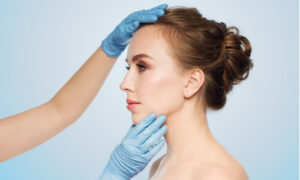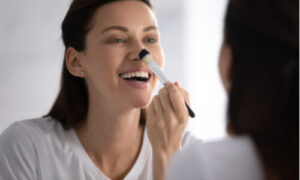Unlike major surgeries such as chest or abdominal surgery, it is easy to determine rhinoplasty recovery time by your appearance rather than your ability to function. Following your treatment, doctors usually gauge your healing by checking for bruises around the area. Identifying the different rhinoplasty swelling stages is useful as there’s no disruption of key bodily functions on the actual procedure. Moreover, rhinoplasty should not hurt because the treatment focuses on making changes only at the cartilage and bone beneath your nose’s skin. So, how long does a nose job take to heal? Continue reading to learn more.
Rhinoplasty Swelling Stages: Overview
For anyone planning to undergo a rhinoplasty procedure, it is normal to take an interest in what to expect after treatment. Luckily, our experts are glad to explain every aspect of the healing process to help you feel at ease and determine what to do at each stage of the procedure.
Swelling After Rhinoplasty Treatment
Following surgery, patients are free to go home and rest. Swelling after rhinoplasty is something that everyone who has surgery goes through. Although your discomfort and swelling should decrease as time passes, unfortunately, there is no quick solution for the congestion. Despite this postoperative swelling, you can already see the results after taking off the splint.
The body needs around three to four months to perform the necessary repair work. By this time, you may notice the majority of the swelling subside. After wound formation, the tissues involved should go through three stages of healing.
Rhinoplasty Healing Stages
We cannot predict the precise number of days you will experience swelling. However, the timetable below will walk you through each stage of your recovery and what else you should expect after your operation.
Inflammatory Phase (Day One to Seven)
The inflammatory phase of healing starts as the surgery begins. This stage might continue anywhere from one to six days longer. Redness, warmth, or flushing of the swelling and incision can cause some discomfort in the areas surrounding the surgery site.
During this time, you should be cautious if a pus-like discharge, fever, and excessive discomfort and pain happen. Although it is quite a rare scenario, these are potential signs of an infection.
Proliferative Phase (One to Six Weeks)

The nasal tissues and incisions may turn thicker. You may also see a small quantity of yellowish discharge in certain wounds. The wound will most certainly stay sore, and there will likely be some tugging, tautness, or sensitivity. Those mild symptoms should remain constant or improve slowly over time.
Some patients may have strange sensations in the tissue operated on when nerve function returns to the treated area. Although this might be unpleasant, it is typically considered an indication that nerve feeling returns to the operated area. These feelings will fade with time.
Remodelling Phase (Six Months to One Year)
The remodelling phase is the body’s last stage of the swelling stages. It can continue anywhere from six months to a year, depending on the degree of the rhinoplasty and whether or not structural grafting is present. At this time, excess collagen begins to break down. The scar will shrink and become less visible, and stiff tissues will give their way to a more flexible and softer nose. Rhinoplasty swelling might take up to a year to reduce, and the final results can take up to a year to emerge.
Rhinoplasty Recovery
The secret to a quicker rhinoplasty recovery is to take care of your nose right after surgery. Ice treatment in the recovery room after your procedure is quite helpful in avoiding or at least decreasing swelling. Experts recommend this technique for the first forty-eight hours.
It is also important to keep your head elevated. Therefore, sleep in an upright position with two to three pillows for the first night. Doing so allows the draining of blood out the nostrils. Draining is preferable because keeping the blood within the tissues can lead to more swelling and bruising.
Tips To Reduce Swelling After Rhinoplasty
Exercise
In the first two weeks following your rhinoplasty, modest walking is acceptable to regulate heart rate and facial movement. However, it is still necessary to remain cautious as vigorous exercise is still not advisable.
The safest time to boost your workout speed should be after the third week. Suppose you’re not sure about which exercises to perform. In that case, it is best to consult with your surgeon to avoid unnecessary injuries.
Avoid Blowing your Nose
It is not advisable to blow your nose for the first ten days. Doing so might release pressure and result in bleeding and swelling. Additional bleeding will result in more bruising, and the recovery process will have to go back to its initial stages. If you want to clear your nose, you should ask for assistance to drain it without pressure.
Clean the Surrounding Areas
You need to cleanse the tip of the nose and its surrounding area with medications, such as an ointment. This technique works by applying ointment inside the nostrils where the dissolvable sutures reside.
Eat Healthily
Knowing what to eat after rhinoplasty has many advantages. In the early stages of recovery, some meals might assist in decreasing swelling. Fresh papaya and pineapple have healing powers because they are high in papain, an enzyme that aids in removing bruises by speeding up the body’s dissolving process.
Get Some Rest
It may be difficult to fall asleep after surgery due to congestion. Still, rest is an important component of the recovery process. Your body heals itself with energy. Obtaining a good seven or eight hours of sleep each night allows your body to replenish that energy.
Avoid Smoking and Alcohol
A reasonable amount of alcohol, such as one or two drinks each day, is perfectly acceptable. Any more of it has the potential to cause instability. Drinking too much alcohol is a risk due to the possibility of a fall and nasal contact injury.
Additionally, smoking is a major no-no since it slows down the healing process. Dryness and heat are both enemies of the nose, so this is a double loss. We don’t advocate it, and most individuals are aware that smoking interferes with quick recovery.
 Be Patient with the Healing Process
Be Patient with the Healing Process
Above everything else, be patient. It will take time for you to recover and achieve the rhinoplasty results you desire. Following the methods above won’t transform a year-long recovery into a week. Still, it will help you get back on your feet faster and have a better post-surgery experience.
Get Revision Rhinoplasty At Melbourne
The recovery timeline for rhinoplasty differs from one person to the next. If you’re still unsure whether or not to have plastic surgery, perhaps we could help you decide.
From the moment you step in at Rhinoplasty Melbourne, a board-certified plastic surgeon will walk you through the whole procedure and healing process. We will offer you detailed information and guidance to be well-prepared before going into the operating room.
Please don’t hesitate to talk to us. Schedule your consultation now or reach us at (03) 9068 5793 for more information.


 Be Patient with the Healing Process
Be Patient with the Healing Process
Recent Comments